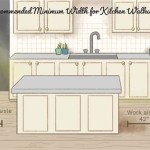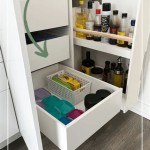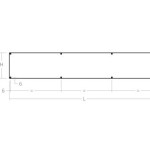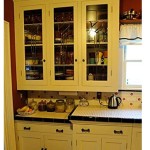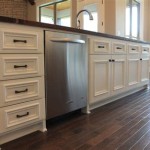How to Organize Kitchen Cabinets
A well-organized kitchen is a source of joy, making cooking and meal prep a more enjoyable experience. Kitchen cabinets, often a chaotic jumble of dishes, appliances, and random items, can quickly become a source of frustration. However, with a systematic approach, you can transform your cabinets into a streamlined and efficient space. This article will guide you through the process of organizing your kitchen cabinets, providing practical tips and strategies for maximizing storage and creating order.
1. Declutter and Purge
The first step in organizing your kitchen cabinets is to declutter. This involves identifying and removing items you no longer need or use. Begin by emptying every cabinet and placing its contents on your countertop. Take stock of each item, asking yourself these questions:
- Do I use this regularly?
- Is there anything else that serves the same purpose?
- Is this item damaged or broken?
Items that answer "no" to these questions can be discarded, donated, or sold. Be ruthless in your decluttering efforts. The goal is to create a clean slate for organizing. This process might seem daunting at first, but it sets the stage for a more efficient and effective organizational system.
2. Categorize and Group Items
Once you have decluttered your cabinets, categorize the remaining items. Group similar items together, making it easier to locate what you need. Here are some common categories:
- Dishes and bowls
- Cookware and bakeware
- Utensils
- Glassware
- Food storage containers
- Small appliances
- Baking supplies
- Spices and condiments
- Snacks and pantry items
This categorization process will give you a clear picture of what you have and how best to arrange it within your cabinets.
3. Utilize Vertical Space
Maximizing vertical space is crucial for maximizing storage in kitchen cabinets. This involves using shelves, organizers, and other vertical storage solutions to create more space for your belongings. Consider these strategies:
-
Adjustable Shelves:
Use adjustable shelves to accommodate items of different heights. This allows you to create customized storage solutions for your cabinets. -
Turntables:
Turntables are ideal for storing spices, condiments, or other smaller items in corner cabinets. They allow you to easily access everything without having to dig through the entire cabinet. -
Stackable Containers:
Opt for stackable containers for items like food storage containers, cups, or bowls. This saves valuable space and keeps items organized. -
Over-the-Door Organizers:
These organizers can be used to store cleaning supplies, snacks, or other items in the cabinet doors.
These vertical storage solutions will make your cabinets feel less cluttered and more functional.
4. Embrace Transparency
Using clear containers for storage is a game-changer in kitchen organization. Transparent storage solutions allow you to easily see what's inside, making finding items a breeze. This avoids the frustration of rummaging through opaque containers. You can use clear containers for storing dry goods, snacks, or any other items you frequently use.
5. Optimize Cabinet Placement
The placement of items within your cabinets is important for maximizing accessibility and functionality. Here are some tips:
-
Most Frequently Used Items:
Place the items you use most often on lower shelves and in easy-to-reach locations. This minimizes bending and reaching. -
Less Frequently Used Items:
Store less frequently used items on higher shelves, in the back of cabinets, or in less accessible areas. -
Heavy Items:
Store heavy items on lower shelves to prevent strain on cabinet doors and hinges.
By strategically placing your items, you can create a more efficient and user-friendly kitchen cabinet system.
6. Take Advantage of Drawer Space
Don't forget about the power of drawers! Kitchen drawers can provide valuable storage space for utensils, cookware, or small appliances. Consider using drawer organizers or dividers to keep items separated and organized. Drawer dividers can be purchased or DIYed using materials like cardboard or plastic. They create separate compartments for different categories of utensils or other items.
7. Invest in Quality Storage Solutions
While it's tempting to opt for inexpensive storage solutions, investing in quality organizers and containers will pay off in the long run. Durable, well-designed storage solutions will last longer, withstand everyday use, and make your organizational system more efficient. Look for organizers made of sturdy materials like metal or plastic, and choose containers that are easy to clean and maintain.
8. Maintain the System
Organization is an ongoing process. Once you have implemented your new kitchen cabinet system, make an effort to maintain it. Put things back in their designated places after each use, and declutter regularly to prevent items from accumulating again. This ensures that your cabinets remain organized and easy to navigate, fostering a more efficient and enjoyable cooking experience.

How To Organize Your Kitchen Cabinets And Pantry Feed Me Phoebe

How To Organize Kitchen Drawers And Cabinets Shannon Gold Design

How To Organize Kitchen Cabinets In 9 Simple Steps Trusted Since 1922

How To Organize Your Kitchen Cabinets Step By Project The Container

How To Organize Your Kitchen Cabinets In 3 Simple Steps Practical Perfection

How To Organize Kitchen Cabinets

25 Best Ideas For How To Organize Kitchen Cabinets

Galley Kitchen Remodel Organization Reveal Organized Ish

Organized Kitchen Cabinets And Drawers Part 1 Christene Holder Home

25 Best Ideas For How To Organize Kitchen Cabinets
Related Posts


